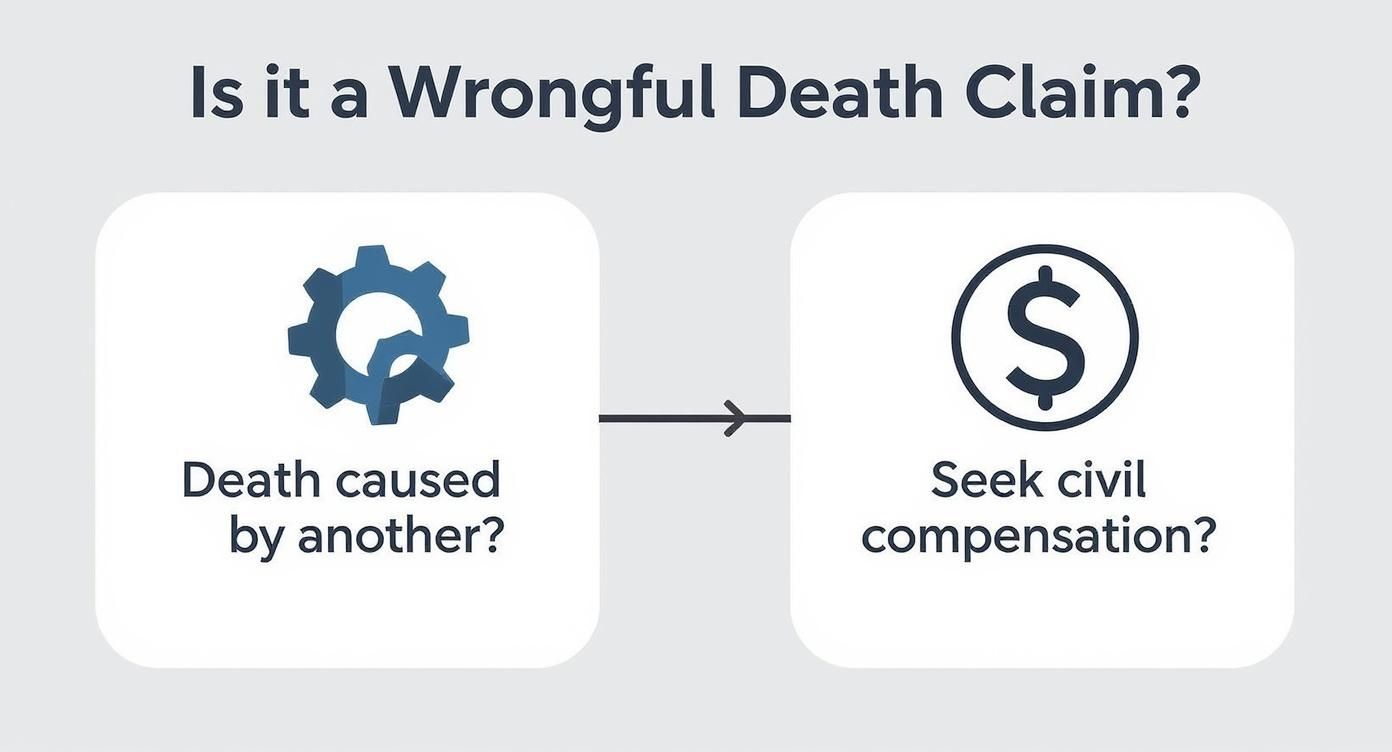Statute of Limitations for Wrongful Death: Oregon Guide
"I was satisfied once John Bell took over my case."
"Communication was always timely."
Statute of Limitations for Wrongful Death: Oregon Guide
When you're grieving the loss of a loved one, the legal system is probably the last thing on your mind. But in Oregon, there’s a critical timeline you need to be aware of: the statute of limitations for a wrongful death claim is generally three years from the date of the injury that caused the death.
This deadline is a legal countdown, and understanding it is the crucial first step toward holding the responsible parties accountable and protecting your family's rights.
What Is the Statute of Limitations for Wrongful Death in Oregon?
Think of a statute of limitations as a legal expiration date. It's a law that puts a strict time limit on your right to file a lawsuit. Once that clock runs out, your ability to seek justice through the courts is gone for good, no matter how strong your case might have been.
Why do these laws even exist? They're designed to keep the legal system fair and functional. By encouraging people to take action promptly, evidence stays fresh—witness memories don't fade, and documents don't get lost. It also gives potential defendants peace of mind, knowing they won't have a lawsuit hanging over their heads indefinitely for something that happened years ago.
Why This Deadline Is So Important
Meeting the statute of limitations for wrongful death is not just a suggestion; it's a hard and fast rule. If you try to file a claim after the three-year window has closed, the court will almost certainly throw it out. The door to the courthouse is effectively locked forever for that specific claim.
For a family reeling from loss, this deadline can feel like an impossible burden. But it's the legal system's way of balancing the need for accountability with the practical challenges of a lawsuit.
It's also important to remember that these timelines are not the same everywhere. The deadline to file a wrongful death claim varies wildly from one state to another, creating a confusing patchwork of laws. Some states give you just one year, many set it at two, and a few allow as many as six. This is why knowing Oregon’s specific rules is so critical if you've lost a loved one here.

Before we move on, let's quickly summarize the key details for Oregon.
Oregon Wrongful Death Statute of Limitations at a Glance
This table provides a quick summary of the key timeframes and rules applicable to Oregon's wrongful death statute of limitations.
| Standard Filing Deadline | Three years from the date of the injury causing death |
| Claim Type | Wrongful Death (Civil Lawsuit) |
| Triggering Event | The date the fatal injury occurred, not necessarily the date of death |
| Consequence of Missing Deadline | The court will likely dismiss the case, barring your claim permanently |
This table gives you the basics, but the reality can be far more complex.
While the three-year rule seems simple on the surface, there are situations and exceptions that can "pause" or even extend the clock. These nuances are precisely why getting legal advice from an experienced professional is so important. The general filing period is similar to the https://www.belllawoffices.com/oregon-personal-injury-statute-of-limitations/, but a wrongful death claim brings its own unique set of challenges and complexities.
What Qualifies as a Wrongful Death Claim
When you strip away the legal jargon, an Oregon wrongful death claim is a civil lawsuit that arises when someone dies because of another person's negligence or wrongful act. It’s the civil justice system's way of holding the responsible party accountable for the incredible loss their actions have caused.
This is a completely separate process from a criminal case, like murder or manslaughter. A criminal trial is about punishing the offender with jail time or state-imposed fines. A wrongful death claim, on the other hand, is about providing financial relief to the surviving family members for the devastating losses they are now forced to endure.
Because the goal is different, the standard of proof is also lower. This means it’s possible to win a wrongful death lawsuit even if the person responsible was never charged with a crime or was found not guilty in a criminal court.
The Core Elements of a Claim
To build a successful wrongful death case, the personal representative of the deceased's estate has to prove a few key things. Think of these as the essential building blocks of your claim.
- Duty of Care: First, you have to show the defendant had a legal responsibility to act with a certain level of care towards the person who died. For example, every driver on the road has a duty to operate their vehicle safely.
- Breach of Duty: Next, you prove the defendant failed to live up to that duty. A doctor who misdiagnoses a fatal illness or a driver who texts behind the wheel has breached their duty of care.
- Causation: Finally, you must connect the dots and show that this specific breach of duty directly caused the victim's death. The car crash that happened because the driver was texting is what led to the fatal injuries.
A huge part of proving causation often comes down to the official cause of death determination, which provides the critical medical evidence needed to link the defendant’s actions to the tragic result.
Recovering What Was Lost
The financial compensation, or "damages," awarded in these cases aims to address the massive, life-altering impact of the loss. It’s not just about paying the final medical bills; it’s about compensating the family for a future that was taken from them.
A wrongful death claim acknowledges that the loss is more than just financial. It recognizes the loss of future support, companionship, and guidance that can never be truly replaced but can be compensated to help the family rebuild.
In an Oregon wrongful death case, the family can seek damages for a wide range of losses, including:
- Medical expenses the deceased had before they passed away.
- The costs of the funeral and burial.
- The lifetime of lost income, wages, and benefits the person would have earned.
- The immense loss of the deceased's companionship, society, and comfort.
These claims offer a path for families to find some measure of justice and financial stability in the wake of an unimaginable tragedy.
How the Discovery Rule Can Change Your Deadline
Oregon’s three-year statute of limitations for wrongful death seems pretty black and white, but the law isn't always so rigid. It has built-in flexibility for situations where the cause of a loved one's death is hidden or unclear. The most powerful exception is known as the discovery rule.
Think of it like a stopwatch that doesn't start ticking the moment someone passes away. Instead, the clock only starts when you discover—or reasonably should have discovered—that another person's negligence was the true cause of death. This simple but critical rule shifts the starting line from the date of the injury to the date you uncover the truth.
This concept is a game-changer in complex cases, especially those involving medical malpractice. A family might tragically lose someone and accept the cause was a known illness, only to find out years down the road that a preventable surgical error was to blame. Getting to that truth often involves digging through complex paperwork, which is why knowing how to get medical records is one of the first, most important steps.
When the Clock Pauses or Resets
The discovery rule isn't the only way the timeline can be adjusted. Oregon law makes allowances for other specific circumstances where sticking to the standard deadline would lead to an unfair outcome. These exceptions are less common, but they are absolutely essential for protecting the rights of those who can't protect themselves.
Here are a couple of other key exceptions that can pause or extend the filing deadline:
- Minor Claimants: When the person with the right to file the claim is a child, the statute of limitations is often "tolled," which is a legal term for paused. The clock might not begin to run until that child turns 18, giving them a real opportunity to seek justice as a legal adult.
- Fraudulent Concealment: If the person or entity at fault actively hides what they did—concealing evidence or outright lying about the cause of death—the deadline can be extended. In these situations, the clock might only start once the deception is finally brought to light.
This infographic can help you visualize the basic questions that kick off the process of investigating a potential wrongful death claim.

As you can see, the first step is always connecting the death to someone else's actions. Once that link is established, the path to seeking civil justice can begin.
A National Perspective on Exceptions
While the specific rules vary, the idea of having exceptions to wrongful death deadlines is common across the country. These allowances for delayed discovery, minor children, or outright fraud are crucial for ensuring justice is served.
Most states recognize some form of the discovery rule, especially in medical malpractice claims where the negligence isn't obvious right away. Similarly, it's widely accepted that the clock should be paused for a minor who loses a parent, usually until they reach the age of majority. Proving that a responsible party intentionally concealed the facts is a high bar, but when there's clear evidence, it can also extend the filing deadline.
Ultimately, these exceptions show that while filing deadlines are strict, the legal system understands that real life is messy and that justice sometimes demands a more flexible timeline.
When the Government is at Fault: Navigating a Different Set of Rules
When a private person or company is responsible for a fatal accident, Oregon's standard three-year filing deadline usually applies. But what happens when the at-fault party is a government agency? The entire rulebook gets thrown out the window.
If you’re pursuing a claim against a city, county, or any state entity, you’re up against a much shorter, far stricter timeline. It's a completely different ballgame, and missing these deadlines means losing your chance to seek justice for good.
Before you can even think about a lawsuit, you have to clear the first hurdle: filing a tort claim notice. This is essentially a formal heads-up, letting the government agency know what happened and that you intend to hold them accountable.
The 180-Day Notice: A Make-or-Break Deadline
This is where the clock really starts ticking. In Oregon, if you believe a public body's negligence led to a death, you have just 180 days from the date of the injury to deliver this notice. This isn't a friendly suggestion; it's an absolute, non-negotiable requirement.
If you let that six-month window close, you forfeit your right to ever file a lawsuit. The standard three-year wrongful death statute of limitations simply won't apply.
It's a harsh reality, but missing the 180-day tort claim notice is one of the most frequent reasons otherwise valid cases against the government are thrown out. It’s a procedural trap that underscores why you cannot afford to wait.
Why such a short leash? The law is designed to give public agencies a fair chance to investigate incidents while evidence and memories are still fresh. It also gives them an opportunity to potentially settle the matter without it going to court.

How This Plays Out in the Real World
It’s crucial to understand how this tight deadline can affect a grieving family. The circumstances are often tragic and unexpected.
Just think about these devastating scenarios:
- A city crew fails to repair a massive pothole or replace a downed stop sign, leading to a fatal collision.
- A child dies during a school event due to the negligence of a public school employee.
- A patient dies in a county-run hospital because a government-employed doctor made a critical error.
In every one of these heartbreaking cases, the family's ability to seek accountability hinges on getting that tort claim notice filed within 180 days. This accelerated timeline makes it absolutely critical to speak with an attorney immediately following a tragedy where a government entity might be at fault. Waiting even a few months could be the difference between getting justice and being left with no legal options at all.
The Consequences Of Missing The Filing Deadline
Picture your right to file a wrongful-death claim as a path blocked by a locked gate. Once the deadline passes, no amount of pleading or new evidence will pry it open.
If you file even one day late, the court must dismiss your case outright. That rule applies:
- No matter how compelling your evidence is
- Even if the other party’s fault is crystal clear
For families who don’t realize how strict Oregon’s timeline is, the result can be heartbreaking.
Why These Deadlines Are So Strict
These deadlines might feel unfair, but they rest on two primary goals:
- Preserving Reliable Evidence
Physical proof can deteriorate. Memories fade. Filing quickly helps ensure judges and juries see the freshest, most accurate version of events. - Providing Finality For Defendants
Individuals and businesses shouldn’t face the endless possibility of a lawsuit from years-old incidents. A clear cutoff date lets everyone move on.
A Statute Of Limitations isn’t a mere guideline; it’s a hard stop. Miss it, and you lose your legal right to compensation forever.
This isn’t meant to scare you—it’s simply how the law works. Once that deadline closes, your chance to hold someone accountable in civil court is gone for good.
Understanding this finality makes one thing clear: time is of the essence. The emotional toll of losing a loved one can be overwhelming, but the clock on your legal rights starts ticking the moment tragedy strikes. Getting advice right away gives your family the best shot at justice.
Practical Steps to Protect Your Legal Rights
When you're reeling from an unimaginable loss, thinking about legal action is probably the last thing on your mind. It can feel completely overwhelming. But taking a few key steps early on is crucial for preserving your family's right to seek justice down the road. What you do in the first few days and weeks can make a huge difference in the strength of a potential wrongful death claim.
The absolute first rule? Don't talk to the at-fault party's insurance company. Their adjusters are trained to sound compassionate and helpful, but their job is to protect their company's bottom line. Anything you say can be twisted and used against you to deny or devalue your family's claim.
Secure Key Evidence Immediately
While a lawyer will handle the formal investigation, you can play a vital role in protecting evidence before it disappears. If you feel up to it, try to gather and keep the following items safe:
- Documents: Pull together any paperwork you can find, like police reports, medical records, and the official death certificate.
- Photographs and Videos: Save any pictures or videos from the scene of the accident, including property damage or injuries.
- Witness Information: Jot down the names and phone numbers of anyone who saw what happened.
Getting a head start on this creates a solid foundation for your legal team to build on, making sure that critical proof isn't lost.
Protecting your legal rights doesn't mean you have to become a legal expert overnight. It means taking a few focused, proactive steps to ensure your family's options remain open while you focus on healing.
Consult an Attorney as Soon as Possible
The most important step you can take is to speak with an experienced Oregon wrongful death lawyer. The deadlines for filing are incredibly strict, and an attorney can immediately take over managing those dates, preserving evidence, and handling all communications with the insurance companies. You can learn more about what's involved when hiring a personal injury attorney to see how early guidance can help.
Of course, the legal side is only one piece of the puzzle. It's just as important to take care of your emotional well-being. Looking into resources for finding grief support groups can provide an essential outlet during such a difficult time. Taking these steps allows you to protect your family’s future without having to carry the entire weight yourself.
Frequently Asked Questions
When you're dealing with the loss of a family member, the legal side of things can feel overwhelming. It’s natural to have a lot of questions. Here are some straightforward answers to the questions we hear most often about Oregon’s wrongful death laws and filing deadlines.
When Does The Three-Year Clock Officially Start Ticking?
This is a point that trips many people up. In Oregon, the three-year deadline usually starts counting down from the date of the injury that led to the death, not from the date the person passed away.
Of course, sometimes the cause of an injury isn't obvious right away. In those situations, Oregon’s “discovery rule” can come into play. This means the clock might not start until the family discovers—or reasonably should have discovered—the injury that was the true cause of death.
Are There Different Rules If The Deceased Is A Child?
The three-year statute of limitations still applies, regardless of how old the person was when they died. But, there's an important exception that focuses on the person filing the claim.
If the beneficiary who has the right to file is a minor, the deadline can be paused, or "tolled." This often gives them extra time, allowing them to file the lawsuit themselves once they turn 18.
The law recognizes that a minor can't take legal action on their own. Tolling protects their right to seek justice, so it isn't lost just because they were too young when the tragedy occurred.
Who Is Allowed To File A Wrongful Death Lawsuit In Oregon?
Not just anyone can file a wrongful death lawsuit in Oregon. The claim has to be brought by the personal representative of the deceased's estate.
This is usually someone named in the will or appointed by the court to act on behalf of the surviving family members. The beneficiaries—typically the spouse, children, stepchildren, and parents—are the ones who receive any compensation recovered from the lawsuit.
Can I Still File A Claim If The Person Who Died Was Partially At Fault?
Yes, in most cases, you can. Oregon operates under a "modified comparative negligence" rule. What that means in plain English is that you can still pursue a claim as long as your loved one's fault was not greater than the fault of the person or company you are suing.
The court will determine the percentage of fault for each party. Any financial compensation awarded will then be reduced by your loved one's percentage of fault. So if they were found to be 10% at fault, the final award would be reduced by 10%.
If you are facing the devastating loss of a loved one and have questions about your legal rights, you don't have to find the answers alone. The compassionate team at Bell Law is here to provide the guidance and support you need. Contact us today for a no-cost consultation to understand your options and protect your family's future. Learn more at https://www.belllawoffices.com.







